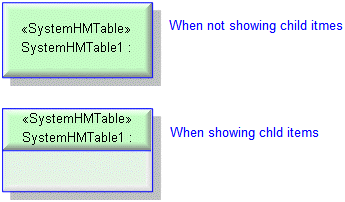System HM table (ARINC for VxWorks code)

A SystemHMTable is a container for other items specifying what states the system can be in, and what errors can occur in those states. For more information see the ARINC SPECIFICATION 653P1-2, December 1, 2005.
A System HM Table models the <SystemHMTable> element in an ARINC 653 configuration, which appears in the Module XML file. The System HM Table's System State Entries, Error ID Actions and Error ID Levels define the content of the <SystemHMTable> element.
The structure of the <SystemHMTable> element is as follows for VxWorks:
<SystemHMTable Name="">
<SystemState SystemState="">
<ErrorIDAction
ErrorIdentifier=""
ErrorAction="">
</ErrorIDAction>
<ErrorIDLevel>
ErrorIdentifier=""
ErrorLevel="">
</ErrorIDLevel>
</SystemState>
</SystemHMTable>
<SystemState SystemState="">
<ErrorIDAction
ErrorIdentifier=""
ErrorAction="">
</ErrorIDAction>
<ErrorIDLevel>
ErrorIdentifier=""
ErrorLevel="">
</ErrorIDLevel>
</SystemState>
</SystemHMTable>
The profile creates a System HM Table when you create an Integration Project through the New > Integration Project command. This System HM Table includes a populated child Configuration Diagram. For more information, see the related links below.
When shown on a Configuration Diagram, a System HM Table's notation is as follows:

You can create a Configuration Diagram for a System HM Table: right-click the System HM Table, point to ARINC, point to New, and then click System HM Table Diagram. On a Configuration Diagram you can open a System HM Table's child Configuration Diagram by double-clicking the System HM Table.
You can view all the System HM Tables in the model through the SystemHMTable folder in the ARINC 653 Profile pane.
A System HM Table is based on a UML Attribute.
The following sections provide information about how a System HM Table is used in the model.
Shown on these diagrams
 Configuration Diagram (Module or System HM Table owned)
Configuration Diagram (Module or System HM Table owned)ARINC properties
None.
The Name property of a System HM Table is generated as the Name attribute of the <SystemHMTable> element.
 System Health Monitoring Table button, and then click within the
System Health Monitoring Table button, and then click within the